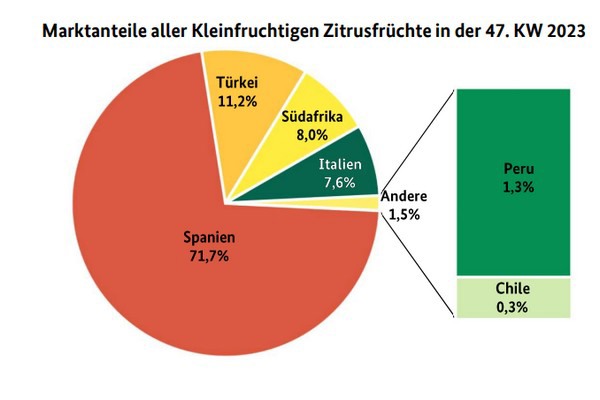As far as satsumas went, only Turkish imports could be acquired in Germany. These became more widely available. In terms of sizes, the fruits generally left nothing to be desired. As demand was good, they were usually easy to sell; in Berlin, they cost between €11 and €15 per 9 kg package. However, according to the BLE, satsumas generally only had a complementary character in a range that was dominated by Spanish clementines: Clemenules and oronules were convincing in terms of their organoleptic properties and were therefore often sold without difficulty.

Nevertheless, it was not always possible to avoid surpluses due to increased deliveries, although the cold and wet weather and the upcoming Advent season led to increased interest. As with netted goods, offers that were too small could usually only be turned over quickly by offering discounts. Italian clementines with leaves were very well received in Berlin, as they tasted excellent.
The first Moroccan batches appeared in Frankfurt, but these generated hardly any interest. Deliveries from Morocco are also expected in Hamburg in week 48. Mandarins from South Africa, Peru and Chile continued to participate in the market. However, their importance dwindled and prices tended to fall rather than rise as customer demand weakened.
Apples
Domestic Elstar, Jonagold, Boskoop and Wellant continued to form the basis of the range. Cox Orange and Topaz had lost some of their relevance. The first Jumani appeared in Berlin, where they cost €1.50 per kg. The main varieties from Italy were Royal Gala and Golden Delicious, which, like Pink Lady, had grown in importance.
Pears
Italian Abate Fetel and Santa Maria dominated, but were still very expensive. The same was true for Williams Christ pears from the same source. In Munich, traders even had to raise their prices once again. This brought demand there to a virtual standstill, which is why customers increasingly turned to the Turkish Santa Maria and Deveci.
Grapes
The presence of the dominant Italian batches slowly but surely diminished, in line with the time of the season. In some places, the prices, which were already quite high, had to be raised once again due to the initial purchase, which immediately limited the available space.
Oranges
Spanish offerings clearly set the tone: Navelina were at the top of the range. Availability had increased, which mostly resulted in falling prices. Newhall from Portugal and Fukumoto from Italy sold easily in Frankfurt. Italian Navelina and Newhall with leaf completed the action in Munich.
Lemons
The same picture prevailed at all markets: Spanish and Turkish deliveries had increased. Demand could be satisfied without any effort. In order to speed up sales and avoid stocks, traders reduced their previous prices slightly.
Bananas
As a rule, supply and demand were sufficiently balanced. Distributors were therefore mostly able to confirm the previous week's calls. Only in Cologne were there slight reductions for the first brand from Panama and the third brands from Colombia.
Cauliflower
There were offers of various origins, with Italian and domestic products forming the basis of the range. Dutch, Belgian and Spanish batches followed in terms of importance. Deliveries from France, Poland and Turkey completed the product range. The approaching end of the Central European season meant that the range was limited.
Lettuce
Iceberg lettuce was available almost exclusively from Spain, with Turkish, Belgian and Dutch supplies only available here and there. Spanish shipments had intensified. Belgian and Italian lettuces dominated the lettuce range, with local and Dutch lettuce rounding off the assortment.
Cucumbers
Spanish cucumbers dominated the market. Dutch offerings were available at all markets, although by no means in all sizes.The trend of falling prices continued.
Tomatoes
The majority of vine tomatoes came from the Netherlands, Turkey and Belgium, while cherry tomatoes mainly came from Italy, the Netherlands and Spain. Belgian and Turkish batches were the main sources of beef tomatoes. Round tomatoes in particular came from Turkey, Morocco and Belgium.
Sweet peppers
Spanish offerings were now unreservedly at the top of the range. They were flanked by Turkish imports. Supplies from Morocco completed the picture. The Dutch, Belgian and Polish seasons were coming to an end: deliveries appeared to be limited and even stopped completely on some days.
Source: BLE
